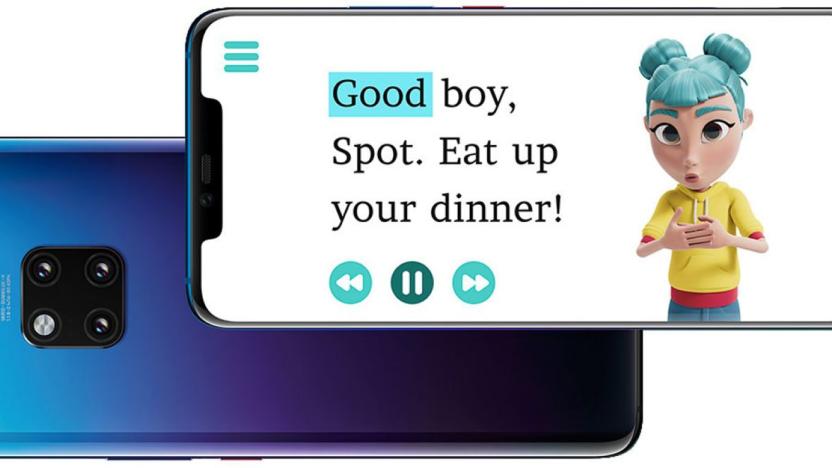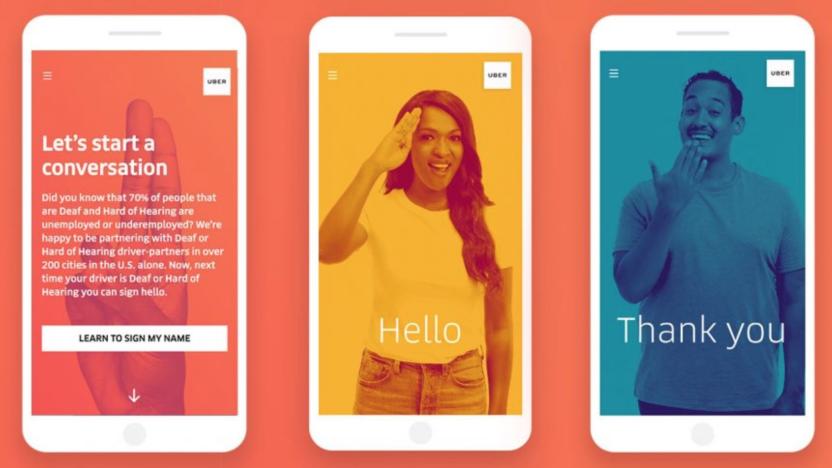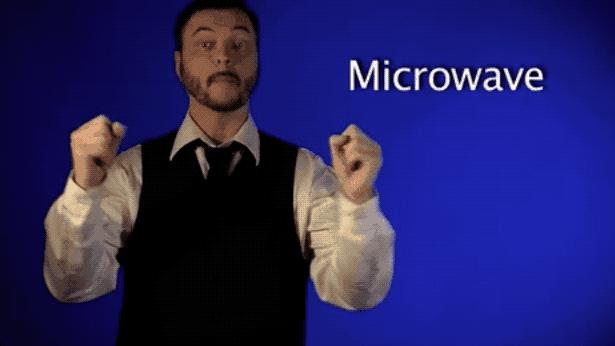signlanguage
Latest

Huawei app uses AI to help deaf children read
Deaf children face challenges learning to read. As their parents and teachers often don't know sign language, young ones can't always make the connection between words on the page and their own life experiences. Huawei aims to fix that with its StorySign app for Android. Point your phone at certain children's books and the app will use AI to translate individual words on the page to sign language performed by an avatar (created by Wallace and Gromit's Aardman Animations, no less). This not only helps children read, but can teach parents the sign language they'd need to tell the story later.

Uber offers basic sign language tips so you can talk to deaf drivers
Back in 2015, Uber added some features for drivers who were deaf and hard of hearing, including visual notifications of impending rides. Today, as a wrap-up for National Deaf Awareness Month, Uber has updated its main app to teach riders how to sign basic phrases like "hello" and "thank you" for drivers with hearing impairments.

The Morning After: Tuesday, March 14 2017
Welcome to Tuesday. Intel has just spent over $15 billion shoring up its self-driving car tech, you'll be playing PS4 games, officially and legally, on your PC and we explain how a microwave works. Because it certainly isn't a camera.

Giphy made 2,000 GIFs to help you learn sign language
A GIF can be more than a well-timed punchline for a tweet or group chat. Now, the looping clips can be used to teach people new languages. As Mashable reports, GIF provider Giphy has launched a new "channel" containing more than 2,000 educational sign language clips. They're all dead simple: just the hand movements and a text caption explaining what they mean. These bite-sized flash cards have been pulled from Sign With Robert, an instructional series for American Sign Language (different versions are used throughout the world). The hope is that people will pick up a word or two by sharing them at convenient moments online.

ICYMI: Animals can communicate better than we'd realized
try{document.getElementById("aol-cms-player-1").style.display="none";}catch(e){}Today on In Case You Missed It: We are adding horses to the list of animals who can communicate via some form of symbolic language, now that researchers taught a group of horses how to understand three symbols related to whether they wanted a blanket covering on or not. With that, horses, primates, dolphins and birds can all communicate with us -- and suddenly old masterpieces like Mister Ed and The Birds have a whole new significance.

Toshiba's new android 'employee' uses sign language, speaks Japanese
Toshiba's newest hire (of sorts) is called Aiko Chihara -- and she's manning a reception desk at the company's booth at CEATEC 2014 in Japan. Oh, and she's silcone-coated robot. Interaction isn't in her repertoire just yet -- a Toshiba spokesman said that it was certainly a possibility in the future -- as Aiko only came into being last month. There's 15 actuators inside the head for expression, while yet more are paired with air compressor to give (unerringly) smooth motion to the arms and hands. Toshiba collaborated with several universities, including Osaka University, to develop the robot and its sign language skills are geared for Japanese (with voice commands narrating along with it). While the bot is lifelike and fluid, there's no intelligence to speak of: actions are all preprogrammed. The company says that there are also plans to teach Aiko American Sign Language in the future, as well as hoping to install the android and its (sign) language skills at other exhibitions and shows in the near future -- something that a handful of other robots are already being tasked with. We've got video-based glimpse of the uncanny valley right after the break.

MotionSavvy uses gesture recognition to give sign language a voice
If you're fluent in American Sign Language, congratulations: you know one more language than most of the people reading this post. The rest of us? A solution to our communicative failures is on the way. A company called MotionSavvy is building a Leap Motion-equipped tablet case that can actively interpret ASL and 'speak' the translation out loud. It's an ambitious project, but it works: at a recent Leap AXLR8R event we saw company founder Ryan Hait-Campbell sign over a MotionSavvy equipped slate. "Hello, my name is Ryan," he said. "What's your name?" It was an impressive demo, but Hait-Campbell admitted it was limited -- the setup can only recognize about 100 words at present, and since signs can vary slightly from person to person, those words don't consistently register for every user. Still, the company's prototype shows enormous potential. If the firm can outfit it with a larger word database and the ability to decipher personalized signing, MotionSavvy could become an incredible communication tool for the hearing-impaired.

Microsoft Research turns Kinect into canny sign language reader (video)
Though early Kinect patents showed its potential for sign language translation, Microsoft quashed any notion early on that this would become a proper feature. However, that hasn't stopped Redmond from continuing development of the idea. Microsoft Research Asia recently showed off software that allows the Kinect to read almost every American Sign Language gesture via hand tracking, even at conversational speeds. In addition to converting signs to text or speech, the software can also let a hearing person input text and "sign" it using an on-screen avatar. All of this is still confined to a lab so far, but the researchers hope that one day it'll open up new lines of communication between the hearing and deaf -- a patent development we could actually get behind. See its alacrity in the video after the break.

Google Hangouts receive sign language interpreter support, keyboard shortcuts
Video chat can be an empowering tool for hard-of-hearing internet citizens for whom sign language is easier than voice. Most chat software doesn't easily bring an interpreter into the equation, however, which spurred Google into adding a Sign Language Interpreter app for Google+ Hangouts. The web component lets chatters invite an interpreter that stays in the background while they verbalize hand gestures. Google is also helping reduce dependencies on the mouse for those who can't (or just won't) use one during chat: there's now keyboard shortcuts to start or stop chats, disable the camera and other basics that would normally demand a click. Both the interpreter app and shortcuts are available today.

Marlee Signs teaches you sign language in your spare time
Marlee Signs is a sign language learning app for the iPhone that introduces you to the basics of American Sign Language (ASL). It is a joint project between MEDL Mobile and well-known deaf actress Marlee Matlin, who provides the sign language lessons for the app. Rather than just static diagrams, the app combines photos and videos to show you how to form ASL's standard hand signals. It includes seven video lessons from Matlin that cover the letters of the alphabet, numbers from zero to nine and common phrases like hello and goodbye. In these lessons, you watch Matlin as she signs the phrase. You can rewatch each video and slow down playback, which is helpful for learning a complex sign. Marlee Signs also includes a spelling section that lets you type in select words and watch how they are spelled using sign language letters. Instead of a video, this section of the app uses still photos of a hand. Each close-up photo shows the proper formation for each letter. Marlee signs is not a replacement for a comprehensive ASL class, but it is an excellent tutorial to introduce you to sign language. It's also a helpful companion for people who are taking a class and want to review the hand signals in their spare time. Marlee Signs is available for free from the iOS App Store. The app ships with seven basic lessons and you can buy five additional lessons for US$1.99 each.

Sigma R&D shows Kinect sign language and Jedi savvy to win gesture challenge (video)
Sigma R&D has won first prize in a gesture challenge to show just how much more talent -- like sign language translation and light saber fun -- can be unlocked in a Kinect. Normally the Microsoft device can only scope body and full mitt movements, but the research company was able to track individual fingers with a Kinect or similar sensor, plus its custom software, allowing a user's hand to become a more finely tuned controller. To prove it, the company introduced a virtual lightsaber to a subject, tracking his swordsmanship perfectly and using his thumb extension to turn it on and off. The system even detected when a passing gesture was made, seamlessly making a virtual transfer of the weapon. The same tech was also used to read sign language, displaying the intended letters on the screen for a quick translation. The SDK is due in the fall, when we can't wait to finally get our hands on a Jedi weapon that isn't dangerous or plasticky. To believe it for yourself, see the videos after the break.

Sign language translator turns gestures into spoken letters, makes for a better world (video)
By far one of the greatest challenges of sign language has been to translate it for everyday folk that wouldn't know where to begin a conversation with the deaf. Cornell University engineering students Ranjay Krishna, Seonwoo Lee and Si Ping Wang -- along with some help from Jonathan Lang -- used their final project time this past semester to close this gap in one of the more practical solutions we've seen to date. Their prototype glove uses accelerometers, contact sensors and flex sensors to translate complex finger gestures from the American Sign Language alphabet into spoken letters: after converting hand positions to digital signals, the test unit both speaks out the resulting letters and sends them to a computer, where they can be used for anything from a game (shown in the video below) to, presumably, constructing whole sentences. Along with being accurate, the Cornell work is even designed with a mind towards how it would work in the real world, as the glove and its transmitter are both wireless and powered by 9-volt batteries. We hope that the project leads to a real product and an extra bridge between the deaf and the rest of us, but in the meantime, we'll be happy that at least one form of powered glove is being put to the noblest use possible.

NHK's automated, animated sign language translator adds gestures to subtitles (video)
We've seen quite a few devices designed to help hearing impaired users communicate via phone or computer, but Japan's NHK Science & Technology Research Laboratories has just announced a new animated translation system to help get important news to deaf viewers . While televised subtitles may work for those who understand the language, people who were born deaf and learned sign language from an early age can have significantly more difficulty. NHK's system, unveiled at Technology Open House 2011, bypasses this problem by automatically comparing Japanese text to sign language, converting equivalent words into animated onscreen gestures, and replacing differing words with appropriate synonyms. There are, however, a few kinks to work out. While comprehensible, the translations aren't exactly fluent and researchers have been forced to manually adjust some awkward transitions between words. The ultimate goal is to create a system that could be used during emergencies or natural disasters, allowing deaf citizens to receive urgent broadcasts as instantly as their hearing compatriots. You can see it in action, after the break.

Storybook app integrates video of sign language for the deaf and hard of hearing
iStorytime has made a new app for reading with children, Danny the Dragon. It's not the content of the storybook, however that's got us excited. This app for iPhone and iPad is one of the first (if not the first) to include video of the story being read with sign language enhancement. Now, if you're expecting something super slick or high tech, you've come to the wrong place. This app incorporates simple videos of the story being read, and a woman signing along. Still, it's a pretty great use of applications, the power of mobile devices, and the app store ecosystem. Video of the app in action is below.

Microsoft says Kinect won't support sign language, downgraded cameras likely to blame
It was mentioned in the patent application, but it looks like Microsoft's Kinect won't be offering support for sign language after all. That's now been confirmed by Microsoft itself, which told Kotaku that it "files lots of patent applications to protect our intellectual property, not all of which are brought to market right away," before flatly stating that "Kinect that is shipping this holiday will not support sign language." The reason? It seems to be the result of Kinect's cameras, which Kotaku says were originally supposed to have a "much higher resolution," but were eventually downgraded to 320 x 240 in an apparent cost-saving move. If you parse Microsoft's, however, you'll noticed that it doesn't exactly rule out the possibility of Kinect ever supporting sign language; it simply says that the version launching this holiday season won't support it.

ZVRS to support live sign language translation via iPhone 4's FaceTime for calls between deaf and hearing users
While SMS and mobile email are great, they still can't match the emotion, interaction, and intonation of a live conversation with someone -- that's why our phones still ship with microphones and speakers, apparently. Of course, this is much more difficult when one of the parties is deaf or hard of hearing, which is where video relay services come in. With the help of a videophone or your computer's webcam, you can make a call with a live translator, who speaks your signed ramblings out loud to the hearing person on the other end. Of course you're usually stuck at a desk when doing this, but now ZVRS is going to be supporting calls made from the iPhone 4 over FaceTime. It might not be quite as sexy as Apple's goosebump-raising iPhone 4 commercial, since the phone obviously makes two-way sign language calls possible, but if the person on the other end doesn't have an iPhone 4 or doesn't know sign language, ZVRS seems like the next best thing. The new service will launch on July 26th. Check out a video of it in action after the break, the actual call starts at 2:25.

Krown's handheld teaches you sign language
Sign language pocket tools aren't all that uncommon, but Krown's latest just exemplifies utility. This relatively low-fi device can reportedly display "short video clips showing how to sign any of 4,500 stored words in US sign language." Unfortunately, there's not a lot of details beyond that right now, but the firm is aiming to launch it in approximately three to four months at around $180.

VeeSee TV brings programming to deaf via IPTV
After hearing that modern technology wasn't exactly doing the deaf any favors, quite a few attempts have sought to reverse the unfortunate trend. Most recently, a new web-based television service has launched in the UK that brings sign language content to IPTV viewers 'round the clock. Dubbed VeeSee TV, the BSL (British Sign Language) channel is currently available via the internet or a set-top-box, and also "includes an interactive forum and user-generated content." Moreover, the creator suggests that this venue will allow "deaf film-makers to show off their own work" while allowing deaf individuals to conveniently catch catered programming anytime during the day. Notably, the service is a part of the ViewTV portal of channels, and while basic content should be up and running right now, a host of new functionality (including webcam conferencing) is planned for the upcoming months.

Detection algorithms to enable sign language on-the-go
Sure, texting has taken the entire world by storm and is likely to remain the next best option to actually speaking to someone for quite some time, but for those who feel that keying in paragraphs of information takes a bit too much time, they're looking for alternatives. Designed to assist the mute and deaf (or those who just love the limelight) who rely on cellphones, the MobileASL video compression project seeks to enable sign language over video telephony, even on less-than-speedy data networks. Developed at the University of Washington, the specialized skin detection algorithms are able to key in on critical moving parts (read: hands and fingers) and utilize the limited bandwidth to broadcast the most important vectors first. The ASL encoders are compatible with the H.264 / AVC compression standard, and while it wasn't directly stated just how viable this option was for those stuck on a 1xRTT connection, you can hit the read link to get in on the user studies if you're down with signing.[Via Slashdot]

Your feet do the talking in Sony's latest ad
Sony's ads just keep on getting weirder. Here's one for the PSP that involves sign language... for the feet. What could this possibly mean? Maybe it means your hands are too pre-occupied playing that your feet must do the talking... OR maybe Sony's working on a new DDR pad for the PSP! [Via AdJab]












